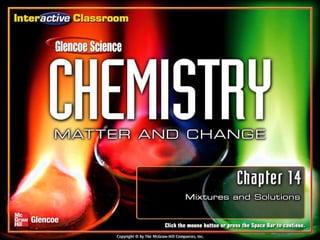
Types of Mixtures and Solutions Guide
- 2. Chapter Menu Mixtures and Solutions Section 14.1 Types of Mixtures Section 14.2 Solution Concentration Section 14.3 Factors Affecting Solvation Section 14.4 Colligative Properties of Solutions Exit Click a hyperlink or folder tab to view the corresponding slides.
- 6. Section 14-1 Heterogeneous Mixtures (cont.)
- 9. Section 14-1 Homogeneous Mixtures (cont.)
- 13. End of Section 14-1
- 16. Section 14-2 Expressing Concentration (cont.)
- 17. Section 14-2 Expressing Concentration (cont.)
- 21. Section 14-2 Expressing Concentration (cont.)
- 24. End of Section 14-2
- 26. Section 14-3 Section 14.3 Factors Affecting Solvation (cont.) solvation heat of solution unsaturated solution saturated solution supersaturated solution Henry’s law Factors such as temperature, pressure, and polarity affect the formation of solutions.
- 28. Section 14-3 The Solvation Process (cont.)
- 34. Section 14-3 Solubility (cont.)
- 36. Section 14-3 Solubility (cont.)
- 40. End of Section 14-3
- 42. Section 14-4 Section 14.4 Colligative Properties of Solutions (cont.) colligative property vapor pressure lowering boiling point elevation freezing point depression osmosis osmotic pressure Colligative properties depend on the number of solute particles in a solution.
- 49. Section 14-4 Boiling Point Elevation (cont.)
- 52. Section 14-4 Freezing Point Depression (cont.)
- 57. End of Section 14-4
- 58. Resources Menu Chemistry Online Study Guide Chapter Assessment Standardized Test Practice Image Bank Concepts in Motion
- 74. IB Menu Click on an image to enlarge.
- 75. IB 1
- 76. IB 2
- 77. IB 3
- 78. IB 4
- 79. IB 5
- 80. IB 6
- 81. IB 7
- 82. IB 8
- 83. IB 9
- 84. IB 10
- 85. IB 11
- 86. IB 12
- 87. IB 13
- 88. IB 14
- 89. CIM Table 14.2 Types and Examples of Solutions Figure 14.10 Dissolution of Compounds Figure 14.19 Strong, Weak, and Non-Electrolytes Figure 14.23 Osmosis
- 90. Help Click any of the background top tabs to display the respective folder. Within the Chapter Outline, clicking a section tab on the right side of the screen will bring you to the first slide in each respective section. Simple navigation buttons will allow you to progress to the next slide or the previous slide. The “Return” button will allow you to return to the slide that you were viewing when you clicked either the Resources or Help tab. The Chapter Resources Menu will allow you to access chapter specific resources from the Chapter Menu or any Chapter Outline slide. From within any feature, click the Resources tab to return to this slide. To exit the presentation, click the Exit button on the Chapter Menu slide or hit Escape [Esc] on your keyboards while viewing any Chapter Outline slide.
- 91. End of Custom Shows This slide is intentionally blank.